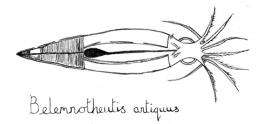Drawing: British Geological Survey (BGS), (c)NERC
(PhysOrg.com) -- Scientists digging in Trowbridge, Wiltshire in England have uncovered the fossilized remains of a prehistoric squid-like creature that lived in the Jurassic period around 150 million years ago. Among their finds was a rock, which they broke open to reveal the intact one-inch long fossilized ink sac.
The ink sac was found to be similar to modern-day squid ink, and as an experiment, the researchers extracted a sample of the black ink and dissolved the ground specimen in an ammonia solution. To their amazement they were able to use the black, inky solution to write with and even to draw a picture of the animal.
The leader of the paleontological dig, Dr Phil Wilby said it is usually only hard parts such as bone and shell that become fossilized, and soft tissue fossils have only been found in a few dozen sites around the world. Dr Wilby explained that sometimes soft-bodied creatures could be turned to stone within a matter of days after death in an effect paleontologists call the Medusa effect, or instantaneous fossilization. The result is a fossil that can be dissected to show even cells and cell nuclei in 3D images when viewed with powerful microscopes.
One of the sites where soft tissue fossils had been discovered in the past was in Trowbridge, where thousands of fossils of Jurassic period fossils were found in the 1840s during the construction of the Great Western Railway. Two years ago, Wilby and his team decided to try and find the almost forgotten site. After locating the site through a series of trial drills, they received funding from the Curry Fund and the British Geological Survey, and were able to carry out a ten-day dig to look for fossils.
During their excavations the team exposed several thousand fossils of the squid-like creature, Belemnotheutis Antiques, in the 265 tons of rock they examined. Dr Wilby explained that it seems likely the area was a breeding site and the thousands of congregated animals were poisoned by algal blooms. In total the team found a couple of dozen specimens with soft parts such as eyes and muscles perfectly preserved. But the ink sac was the most exciting find.
Part of the fossilized ink sac has been sent to a Yale University laboratory in the US for detailed chemical analysis. The rest of the specimen is now in Nottingham in the British Geological Survey collection.
More information: Geology Today, Volume 24 Issue 3, Pages 95 - 98. DOI: 10.1111/j.1365-2451.2008.00666.x
© 2009 PhysOrg.com





















